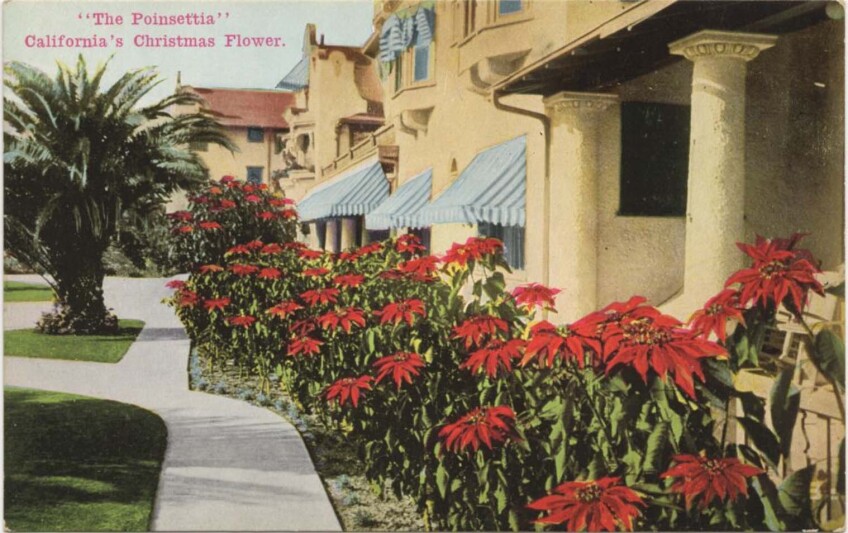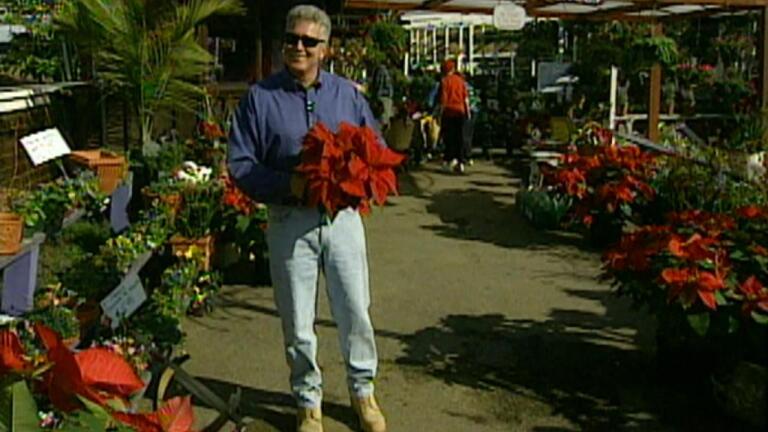How Poinsettias Became a Christmas Staple

Gone are the days when you could get in the car on a bright December afternoon and drive out Sunset Boulevard from Hollywood to Pacific Palisades to see poinsettia fields along the way."Sunset Magazine," December 1964
On a wintery day almost 100 years ago, a windstorm blew through a field of poinsettias, destroying most of the plants. This sent members of the Ecke family scrambling to salvage the blooms. Surprisingly, Paul Ecke Sr. remembered this as "one of our very best days." In the 2008 book "Sending Flowers to America," he explained, "we just cut the whipped red flowers and tied them in bunches. The movie colony came out and stormed us, just to get something for their house. We blocked traffic for 3/4 of mile on each side of our stands."
In 1924, the Ecke family managed several poinsettia stands and perhaps this one was the stand mentioned in Victoria Padilla's book "Southern California Gardens." As Padilla explained, "Many residents of Los Angeles will remember the field of poinsettias that brightened the corner of Sunset and Sepulveda Boulevards in West L.A. during the winter season. This planting was part of the Eckes' growing grounds until the freeway took over."

These growing grounds were part of the family's larger poinsettia business started by Paul Ecke Sr.'s father, Albert Ecke. When the Swiss-born patriarch and his young family arrived to the U.S. from Germany in 1902, they were actually on their way to Fiji to open a health spa. The elder Ecke had operated a vegetarian sanitarium in Germany before coming to the U.S. After experiencing the Southern California climate, they planted roots here (pardon the pun).
They first owned a small farm in Eagle Rock, where tragedy struck the young family. At age 13, the oldest son Hans accidentally shot and killed his 11-year-old sister Marguerite. The two youngest children, Paul and Frieda, witnessed the horrific event, which was deemed an accidental death.

Perhaps to start a new chapter, the family moved to Hayworth Avenue in 1906 in what is now West Hollywood. Ecke started growing chrysanthemums, gladiolus and poinsettias and eventually concentrated on poinsettias when he saw how well this winter-blooming shrub grew in Los Angeles.

While poinsettias had already been available at nurseries across the U.S. and Los Angeles, it was Ecke, and later his son Paul, who transformed the poinsettia market from selling cut flowers as bouquets to selling them as indoor potted plants for Christmas.
A Brief Botanical History of Poinsettias
The poinsettia is named after Joel Roberts Poinsett, the first U.S. ambassador to Mexico from 1825 to 1829. A number of historic sources recount the story that Poinsett saw this winter-flowering shrub as part of a nativity scene in Taxco, Mexico and then sent cuttings to South Carolina. The 2011 publication "Chronica Horticulture" questions this account, as documentation only shows that plant specimens were received in the U.S. in 1828 and 1829 — about the same time Poinsett was in Mexico. Apparently, Poinsett meddled so much in the political affairs of the young country, the Spanish term poinsettismo was coined to describe an intrusive style. He became such a political problem he was recalled back to the U.S. in December 1929 and left Mexico on Christmas Day.
The shrub has a long and storied history in Mexico dating back to the Aztecs, who called the crimson plant cuetlaxochitl. In his book "Drink Cultura," Jose Antonio Burciaga explained that the plant represented purity "and its name signified 'Flower that withers, mortal flower that perishes like all that is pure.'" The Aztecs used the plant for red dye and as a medicine for fever. In Mexico, it's also called flor de nochebuena — and before it was renamed by botanists, the plant was known in the U.S. as "painted leaf" or "Mexican fire plant."

The Rise and Fall of a Poinsettia Empire
After the Ecke family's patriarch died in 1919, Paul Ecke Sr. took over the business with help from his sister Frieda and eventually moved operations down to Encinitas. While the larger operation moved toward San Diego, the family kept growing fields and packing houses in Hollywood and Westwood. In the 2008 book, "Sending Flowers to America," Paul Ecke Sr. recalled that in the 1930s, the Rodeo Land and Water Company gave them as much free land as needed in what is today's Beverly Hills in order to beautify the communities. And in Westwood, the Janss Investment Company also gave them free land to add color to the growing development.
One packing house was located on 9000 block Sunset Blvd., now the site of the Roxy Theatre. In a 2008 interview, Paul Ecke III explained that as far as he knew, the old timbers from that packing house can still be seen in the Roxy on Sunset Boulevard.

In an L.A. Times interview, Paul Ecke Sr. recounted, "We moved down here in 1923 after Dad died. I realized the boom was coming, buildings would soon edge us out, it was time to look elsewhere." That year, he planted 12 acres of poinsettia plants, hopeful for a successful crop the following year. But the same windstorm that blew apart the flowers at Sunset and Sepulveda also destroyed that first crop along the 101 Freeway. Not a single plant could be salvaged.

That misfortune was short-lived, as the family farm went on to successfully operate for decades in Encinitas — which, according to one 1930 reporter, looked like a "mammoth Christmas card against the barren hills" with all those "blazing scarlet blossoms."
The Ecke family sold the last of the Encinitas farm in 2012 and, a year later, donated the business archive to California State University-San Marcos. In addition to documenting the history of the Ecke family, the Paul Ecke Ranch Records also tell the larger story of how his West Hollywood farm grew into a poinsettia empire.






